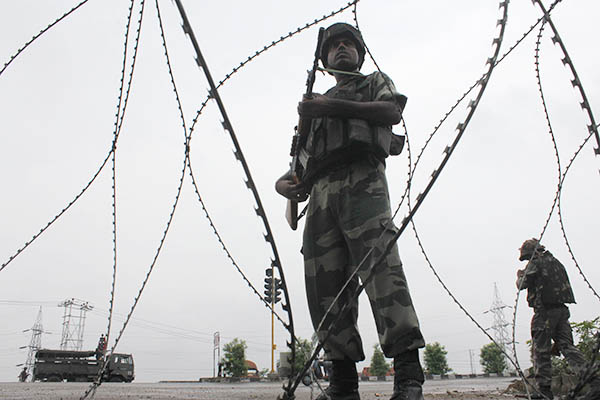
File photo. AFP
Gen. Pervez Musharraf’s desire to ‘normalize’ ties with India was an idea ahead of its time
On Aug. 5, 2019, India revoked the autonomous status of Jammu and Kashmir under its occupation through a vote in its upper house of parliament, the Rajya Sabha, where the ruling Bharatiya Janata Party (BJP) did not have a majority. It revoked Articles 370 and 35A of the Indian Constitution, which allowed a special status of autonomy to the occupied territories. Was this the only way India wished to resolve the Kashmir issue? Not really. It had mooted a formula that was just the opposite of “annexation.”
Gen. Pervez Musharraf, who ruled Pakistan from 1999 to 2008, did something that future generations will continue to marvel at. As a general and president of the republic of Pakistan he actually thought—in 2006—of resolving the Kashmir dispute with India forever. One would say that it was the first statesmanlike move from Pakistan to break a decades-long hostile deadlock; but one would have to also take into account the tenure of the statesmanlike Prime Minister of India, Atal Bihari Vajpayee, in office from 1999 to 2004, who actually created the atmosphere for it.
Vajpayee-Nawaz Sharif agreement
To set the record straight, it was Prime Minister Nawaz Sharif of Pakistan who thought of buying the “normalization” line of Vajpayee and started being “receptive” to the “four-point formula” Vajpayee had put to him when he visited Lahore in February 1999. Three months later, as if reacting to the Vajpayee-Sharif Lahore Declaration, Pakistan Army chief Pervez Musharraf launched his “secret” Kargil war in Kashmir, which, ending in defeat, perversely led to the overthrow of Nawaz Sharif as prime minister. Then, seven years later, even more perversely, Gen. Musharraf changed tack in 2006 as a “commando general” and began to believe that both Pakistan and India would have to retreat from positions held since 1948; and he came up with his not-so-original “peace” formula.
Musharraf announced a 4-point “solution” that actually constituted a major departure from Pakistan’s previous Kashmir policy. He proposed five major shifts in Pakistan’s decades-long stance on Kashmir: 1) setting aside the U.N. resolutions on plebiscite; 2) proposing self-governance instead of self-determination for Kashmir; 3) forsaking religion as a criterion; 4) advising Kashmiris to talk to New Delhi instead of defiance; and 5) accepting the Line of Control (LoC) as the formal border, provided it is combined with joint management. It must be said, however, that it was then-P.M. Nawaz Sharif who had thought of buying the “normalization” line of India and started being “receptive” to Vajpayee, who had actually offered the “four-point formula” to Sharif in 1999.
The fate of the formula
The proposed formula, unsurprisingly, met with different reactions from inside Pakistan, Kashmir, and India. Pakistan’s national leaders Benazir Bhutto and Nawaz Sharif advised Indian leaders not to reach any deal with President Musharraf on the Kashmir issue. Sharif’s comment on the “4 point formula” was: “This gentleman Musharraf announces very important things off-the-cuff. He has the habit of taking decisions in a very casual manner. He is also erratic, a little impulsive. I don’t agree on a lot of things with Mr. Musharraf. But then one has to look into this. One will have to study this. We don’t have to go by what Mr. Musharraf says. Let us sit down and see how best we can resolve this issue.”
Later, then-Prime Minister Yousaf Raza Gillani reacted to the peace formula saying, “They were half-baked things that did not have the mandate of Parliament.” In India-held Kashmir, however, Professor Abdul Ghani Bhat, a former chairman of the Hurriyat Conference, had responded to the “Musharraf formula” saying: “The proposal was in fact not only an acceptable solution but a very workable one too, where no party would have suffered the painful sense of defeat: neither the Indians nor the Pakistanis and not even the people of Kashmir.”
Kasuri diplomacy
Musharraf’s foreign minister, Khurshid Mahmood Kasuri, who served as Minister of Foreign Affairs of Pakistan 2002-2007, was enthusiastic about the formula on which he expatiated later in his book Neither a Hawk Nor a Dove (2005) saying there was nothing wrong in attaching priority to normalizing relations with India. Normalization would have meant the two neighbors behaving “normally,” enjoying cross-border and transit trade for which regional states had floated many transformational projects, like the Iranian gas pipeline going to India through Pakistan and the Tajikistan-Afghanistan-Pakistan-India (TAPI) gas pipeline with the potential to transform South Asia into a prosperous subcontinent. But there was angry reaction from a section of the Pakistani press against what it deemed was an implied compromise on policy.
The “rejectionist” line was familiar from the past and was based on the perception that “normalization” would put the “core” dispute on the backburner. General Musharraf came under attack when he began his 2001 diplomacy with India—then under Vajpayee—with the theme of “mutual flexibility.” The idea was then, as is now, to get India to talk. Kasuri was in favor of normalization in this context. The world was supportive of Pakistan on the issue of bilateral talks, and what the world wanted through these talks was “normalization of relations between India and Pakistan.”
Inbred hawks and their doctrines
In the eyes of the Pakistani hawks, India, as the status quo power, wanted “normalization” rather than “resolution.” They thought Kashmir jihad was going in Pakistan’s favor, and India was under pressure. When the two came to the negotiating table, however, and India proposed “normalization first” and “Kashmir dispute” later, the hawks balked. Because of the delusion of jihad, Pakistan stuck to the precondition of resolving Kashmir first, as it thought that India under the duress of jihad would surrender to the demand of “plebiscite,” thus surrendering Kashmir to Pakistan.
Jihad, in fact, had fulfilled its natural parabola and tended to slump towards the end of the 1990s. A kind of “balance” was achieved: both India and Pakistan felt the pressure of making a compromise on the “core issue.” This phase was unfortunately ended by the change of government in Pakistan in 1999. Two years later, however, the “takeover”-general, Pervez Musharraf, began to woo India himself; but neither he nor the BJP government was fully in control at home to undertake the kind of statesmanship that was required for what was essentially a compromise. After 9/11, however, India leaned on the American campaign against terrorism—and consequent pressure on Kashmir jihad—to attach a precondition to “normalization”: that of ending “cross-border terrorism.”

File photo. Sajjad Qayyum—AFP
Jihad revisionism
The line coming from the Pakistani hawks continued to be that India, as the status quo power, always wanted a normalization of relations with Pakistan to bypass and “freeze” the Kashmir dispute. Pakistan, as the anti-status quo power, wanted to create conditions that would first bring India to the negotiating table to discuss only Kashmir on the basis of U.N. resolutions. From the war in 1965 to the Kargil Operation of 1999, Pakistan had acted as the revisionist power trying to force India to retreat on Kashmir. By the end of the 1990s, in the post-cold war period, Pakistan was compelled to pay attention to the fact that the world was less and less willing to pay attention to the crisis in Kashmir.
Pakistan had become alarmed when an attempt was made to delete the Kashmir issue from the record of the U.N. Security Council. Now the policy in Islamabad was to “highlight” the Kashmir issue and compel the world to pay attention to it. Talks with India stalled because the two parties could not agree on the “core issue” conditionality. In view of the long history of Indo-Pakistan epochal war of 50 years, the world responded by advocating a covert normalization through what it called confidence-building measures (CBMs).
Why the world abandoned Pakistan
When the U.N. resolutions were handed down in 1948, Pakistan was a secular state and had not yet been Islamized under the Objectives Resolutions. The Security Council resolution requiring India and Pakistan to hold a plebiscite in Kashmir was not compelled to consider the status of the three million non-Muslims falling to Pakistan in case the Kashmiris opted to join it. From 1971 onwards, however, Pakistan was less preoccupied with Kashmir because of the defeat in East Pakistan and was more focused on getting its 80,000 prisoners-of-war out of India.
Under General Zia, when the law was Islamized, the status of non-Muslims in Pakistan was directly affected. It is difficult to say if General Zia ever considered how his Islamization would damage the international support on Kashmir that Pakistan was counting on during the cold war. It is certain that the civilian politicians who passed the anti-blasphemy laws in the 1990s—when the Kashmir insurrection was on the boil—simply did not care for the international isolation they were inviting by doing so. And Kashmir was not at all on their minds.
